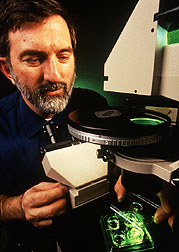Forum—The Promise of Dolly
|
|
Dolly, a sheep unremarkable except for her origin, has caused us to stop and think.
Dolly, as the world knows, is the sheep cloned at Scotland's Roslin Institute. Since the formal announcement of her existence, there has been an intense public debate over the ethics of cloning both animals and humans. What hasn't been heard is the thinking behind Dolly's creation.
The scientists at Roslin Institute have conducted research for many years to produce rare drugs in the milk of sheep and cattle. That research was sparked by a U.S. Department of Agriculture study that showed new genes, including human genes, could be inserted into sheep, pigs, and rabbits.
Some dozen years after this USDA study, the research at Roslin has begun to pay off. The Roslin scientists introduced into sheep a modified human gene that promotes production of the human protein alpha-1 antitrypsin.
The Roslin scientists found that the human gene functioned in sheep and caused alpha-1 antitrypsin to be produced in the sheep's milk. The Scottish biotechnology company PPL Therapeutics has purified the human protein from the sheep milk and is testing it as a drug for the treatment of emphysema.
After seeing the power of this technology for alleviating human pain and suffering, many researchers sought support to conduct similar research on genes that produce other rare human proteins. Scientific reports indicate that human proteins for several blood clotting factors and for one antibacterial protein have been produced in animals' milk.
USDA's investment in research to understand genes and how they work appears to have produced an early payoff in biomedicine.
Dolly represents a new approach to inserting genetic information into animals. How does this new approach improve on the method reported by USDA?
In the earlier method, genes were injected into eggs. But the success rate was low. Less than one out of a hundred eggs would ultimately produce an adult animal with the inserted gene. Meanwhile, the investment in surrogate mothers for the 99 eggs that didn't carry the new gene made the research expensive.
In contrast, Dolly was produced from cells grown in the laboratory. In theory, if a new gene had been added to those cells, then all of Dolly's cells would have carried the new gene. Experiments are under way to test this assumption.
Returning to the issue of the benefits of cloning—will we produce much of our lean meat from clones? It seems unlikely, at least for a while. Producing Dolly was expensive and inefficient.
Also, we must protect the genetic diversity of our food-producing animals so they can respond effectively to challenges such as emerging diseases or climatic change. If all animals were genetically identical, they would all have the same vulnerabilities.
It is possible that with appropriate germplasm conservation programs, we can design farm management programs to maximize the consistent qualities of a set of clones.
We in USDA's Agricultural Research Service expect to put the methods that produced Dolly to a variety of uses. For example, they might help us learn more about the genes behind whether an animal uses food to make muscle or fat and about the genes that control a cow's level of resistance to mammary gland infections. They will aid the study of methods to make milk an even healthier food for people—especially infants—and there will be other studies that we have yet to envision.
Just as the basic research at USDA was the predecessor to Dolly, the new research made possible by Dolly will ultimately pay off in many ways, for animals and people alike.
Caird E. Rexroad, Jr.
Research Leader,
ARS Gene Evaluation and Mapping Laboratory,
Beltsville, Maryland
This page last updated June 2005.







